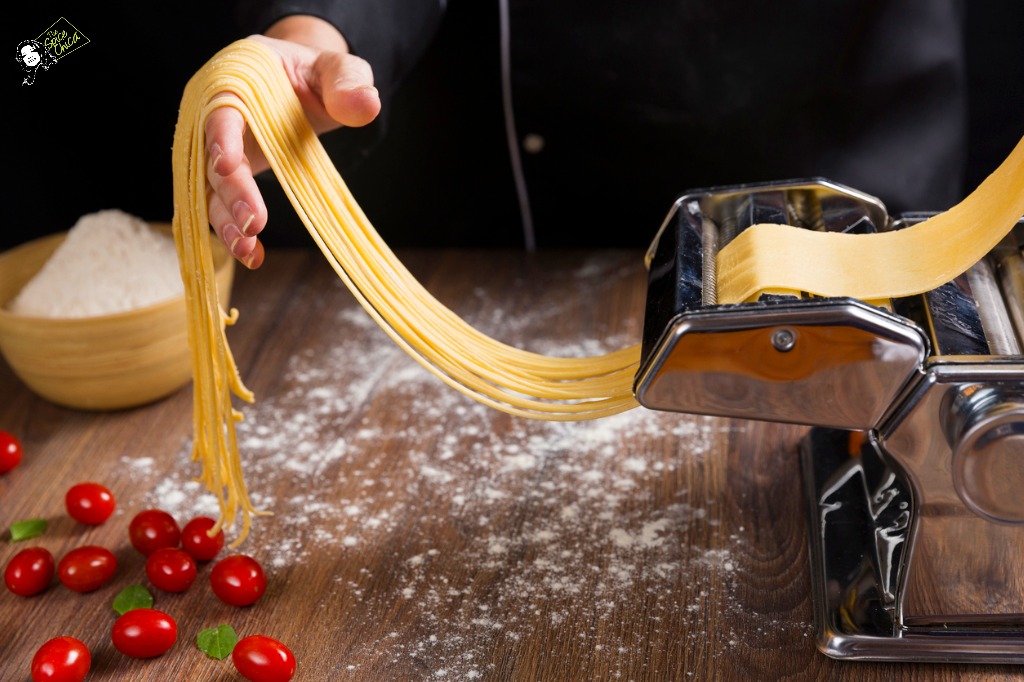There is no one correct recipe for fresh pasta. In Italy, different regions have different ways of making it. Some places only use eggs and flour and others use only water and flour. Some cooks add a little salt and olive oil, some do not. You will have to experiment and decide what pasta recipe you like. How do I like to make mine? I basically make my pasta the way they do in the Emilia Romagna region of Italy – with just fresh eggs and flour.
Although you can certainly use the eggs you buy in the grocery store and good old plain All Purpose flour, if you want to take your pasta to the next level, you can use superior ingredients – after all, if there are only two ingredients in fresh pasta, why not make them the best? If you can, buy fresh farm eggs. The yolks are richer and darker in color – your pasta will be better tasting and golden. Try to let your eggs come to room temperature because it will make the dough easier to work. For the flour, Italian 00 flour is a special treat, as it makes a very delicate pasta. Italian 00 flour is very finely milled flour, high in protein and very soft.
Making flavored pastas is easy, too. The tomato pasta above just has a little bit of tomato paste added to the dough. That’s it. The video in this post shows how to make spinach pasta by just steaming a little bit of fresh spinach and making the dough with that. For spinach pasta, it’s better to make the dough in a food processor because it blends the spinach a little better than by hand (although you can certainly do it by hand – just chop the spinach very finely before adding it to the dough). There are all kinds of flavors you can add to pasta once you master the basic plain pasta – peppered pasta, beet pasta, saffron pasta, herb pasta, and on and on. If you make flavored pastas that use moist or wet ingredients like tomato paste or spinach, you will need to add a bit more flour until you get a dough that is not too sticky.
the basic recipe for the pasta dough is about 1 egg to every 3/4 cup of flour. Of course, this will vary on how big the egg is, how fresh, and what kind of flour I’m using. So it’s just a starting point. I may add just a little water to the dough if I think it’s too dry. If you would like a richer pasta for a special occasion, add more egg yolks to the dough. It will be wonderful.
After you make the dough, it must rest a little. Wrap the dough in a piece of floured plastic wrap and let it sit at room temperature for about 20 to 30 minutes. It will be easier to roll out.
Rolling out the pasta is not hard – you will get the hang of it pretty quickly. After the pasta has rested, cut off a piece about the size of the palm of your hand. Adjust the pasta rollers to #1, the widest setting, and put the pasta through. Make sure you flour the pasta dough lightly so that it doesn’t stick to the rollers. After the dough comes through the rollers, fold it into thirds and pass it through the #1 slot again. Do this a couple of more times. The pasta will become very soft and velvety. Adjust the rollers to the next thinnest setting, #2, and put the pasta through. Do not fold the pasta this time. Keep passing it through the rollers, adjusting them thinner, until you reach the thickness you like. I usually stop at #5 or #6 (for ravioli, never go beyond #5 because it will be too thin). As you pass the pasta through narrower settings, the pasta may become sticky again – keep lightly flouring it.
At this point, you now have fresh pasta sheets that you can make homemade lasagna with. After rolling out the pasta sheets, they must dry just a little on the counter if you want to make a cut pasta, like linguini or fettuccine. If you cut them before they have dried a little, the cutters will not cut them cleanly through. Dry them too much, however, and they will be brittle.
After your pasta has been cut, I have found that the best way to store them pasta is on a rimmed sheet pan. Toss the pasta with a little flour so it does not stick. Cover lightly with plastic wrap and place in the fridge until you cook it. I usually make the pasta in the morning but I have even made it the day before I needed it and it has done just fine in the fridge. It will stay supple and not become brittle, if you refrigerate it. Toss the pasta every once in a while with a little more flour, just to make sure it doesn’t become sticky.
This recipe (1 egg + 3/4 cup flour) produces about 5 to 6 ounces of fresh pasta. It is easily doubled, tripled, etc.
To cook the pasta, boil it for only about two minutes in a large pot of salted water.


